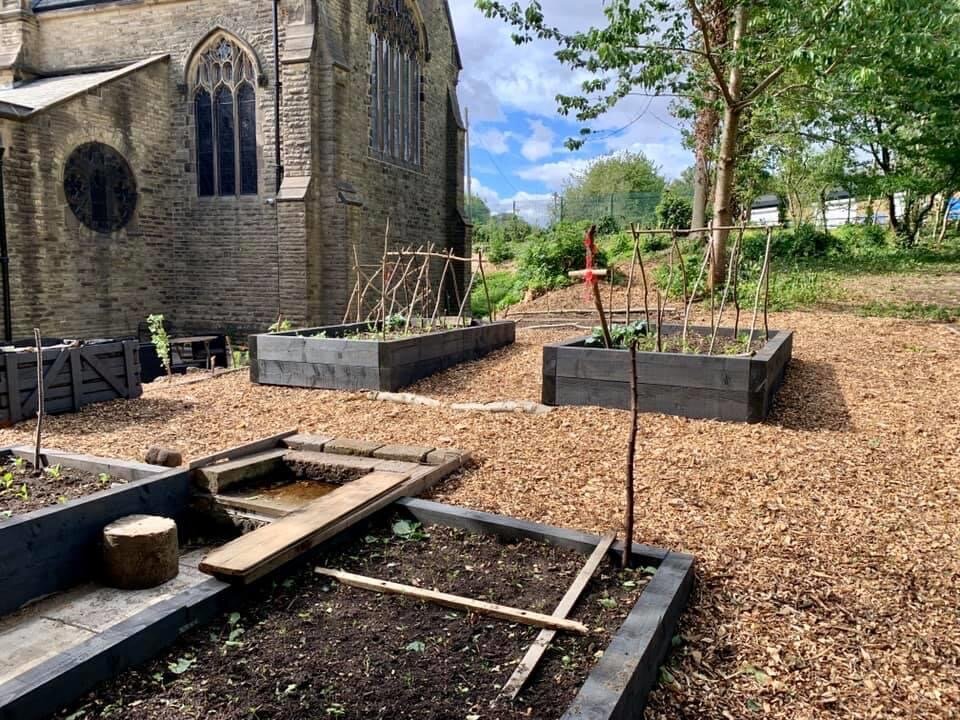The Wonders of Creation
Guest User
Lisa Vallente-Osborne reports on a remarkable transformation of the wasteland behind the church at St Joseph’s which has become a beautiful parish garden:
“As the Covid lockdown 1.0 saw most retreat to their homes; a new development at St Joseph’s Lancaster began to emerge. With the change in workload and daily rhythms, Fr Philip began clearing a wasteland area at the back of the church and ordered the seed to sow grassland.
It was at this point we turned up. 15years ago, when I first saw this land, I have envisioned a community vegetable allotment/kitchen garden. At this point it’s was finally possible!
Over the space of the next few months, the ground was dug by our small family bubble. As the railway sleepers arrived, the grass seed was returned and the veg garden came into being. A plot with a fruiting terrace and three pre-loved recycled greenhouses. The sisters at Hyning Monastery supported us with some veg seedlings for growing in the first year, and taught and guided us through sowing seeds for this next season. This year’s crop is mainly from seeds.
As the church reopened and people returned to the building they were welcomed to a new garden. The space provided a Covid safe meeting space, the large greenhouse became a meeting room and a confessional through the passing months. The fruit and veg produce was offered to parishioners for donations, with the proceeds going towards funding the next year’s planting.
Throughout Covid lockdowns 1.0 and 2.0, as the restrictions allowed, the volunteers emerged to help tend our little Eden. It rapidly became a haven to preserve sanity! The space has rapidly become a little haven where people came to rest, to work and to play, reconnecting with nature and enjoy the outdoor space.
Local builders became aware of the project and continue to donate any excess from their trade from stone to planks! We even have a local lady who supplies pallets, which has been used to build fencing, benches and various planters! A local supplier brings locally sourced peat free compost, and the most important local, our horse poop lady providers her ‘donations’ on a regular basis! Many of the volunteers and regular donors are not from our regular church community. In fact, most are agnostic or atheist. Through the garden, all feel welcomed, intrigued and love to watch all the ‘developments around the back’ of the church, leaving a little more curious about what makes ‘us Catholics tick’. And as all become more familiar, the conversations deepen.
Our community plot borders with our St Joseph’s primary school. These children have watched with inquisition and awe as ‘the monsters’ (pumpkins) grew by the fence, and classes visit us regularly to see some of Gods creation unfold. They and others will undoubtedly continue to visit!
This garden project has linked us in with other local allotment holders. I regularly visits these, and their members come to our St Joes garden too. The links with Hyning Monastery are strong (as I am an oblate there) but also new links are being forged with Nazareth House too! Our garden is on the Hedgehog preservation map, and we have opened Hedgehog highways between us and the school and provided various shelters for wildlife. Our new pond is thriving with tadpoles, and the garden has never seen such a diverse bird population and all their little chicks in quite some time!
At the beginning, as the garden took shape me and a volunteer prayed for bees and a beekeeper. Little did I know that person being trained would be me! (Note to self- be very careful what you pray for!). So as of today, this latest development has seen us restore one of the Catholic Churches most ancient traditions of ‘bee-keeping’. We joined up the the Lune Valley Beekeepers initially for advice to offer space for hives, and then for support and training.
So the garden is predominantly an allotment. But since it was apparent that bees were coming, many parishioners have supplied flowering plants, trees and herbs. Our space developed further offering a ‘Snug’ (a seated area perennial garden to supply the bees with nectar all year round) and a specific prayer garden courtyard (where people can sit in peace, reflect and pray).
The space is used as a safe haven by so many. From parishioners who grab a coffee and sit with their children after a weekday mass, to refugee families who meet up to reconnect.
From a barren land, Covid helped to bore and birthed, a living, breathing space for connection. It soon became a space to find peace, pray and a place to watch the great tapestry that is the wonder of creation unfold. Through the gentle birdsong, the buzz of the bees and the invisible unfolding of new leaves, our creator connects with humanity; and our mission field expands.
“But ask the beasts, and they will teach you;
the birds of the heavens, and they will tell you;
or the bushes of the earth, and they will teach you;
and the fish of the sea will declare to you.
Who among all these does not know
that the hand of the Lord has done this?
In his hand is the life of every living thing
and the breath of all mankind. — Job 12:7-10 (ESV)





